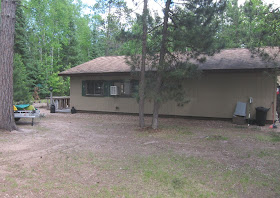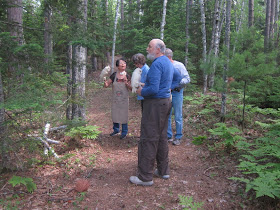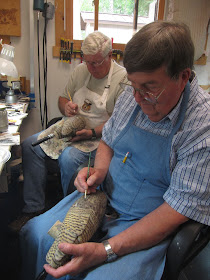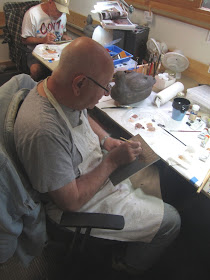A Very Special Fundraiser-
Roseate Tern sculpture for the Faulkner's Island Light Brigade-
I carved this Roseate Tern sculpture for fundraising efforts for the Faulkner's Island Light Brigade. This sculpture/carving will be placed in a Silent Auction-
Falkner Island is a 2-hectare (4.5-acre) crescent-shaped island located in Long Island Sound about 5 km (3 mi) south of Guilford, New Haven Co., Connecticut at 41 degrees 13' N, 72 degrees 39' W. A detailed description of the island and its recent history is given in the book The Island Called Faulkner's by Joel Helander. Since the 1960s, Falkner Island has been the site of the largest Common Tern (Sterna hirundo ) and Roseate Tern (S. dougallii ) colony in Connecticut, and it is now the site of the third-largest Roseate Tern colony in the northeastern U.S.
http://www.pwrc.usgs.gov/resshow/spendlow/rosetern.htm
For Details concerning the Silent Auction, please check the FILB's website:
http://faulknerslight.org/
Well, off to Maine for a long week of sea birding! We will be visiting Vinalhaven spending two days on a private charter with John Drury for Puffins, alcids, and that wondering Red-billed Tropicbird. We will also visit Monhegan, Eastern Egg Rock, Matinicus, and a few other offshore islands and locations. Hopefully we will have a fabulous trip. Keep watching for the report!
Keith Mueller, Killingworth
A Special Birding Experience- Bird Artists Migrate North to the UP of Michigan
Three weeks of enjoying birds with wood and oil paint!
Roseate Tern sculpture for the Faulkner's Island Light Brigade-
I carved this Roseate Tern sculpture for fundraising efforts for the Faulkner's Island Light Brigade. This sculpture/carving will be placed in a Silent Auction-
Falkner Island is a 2-hectare (4.5-acre) crescent-shaped island located in Long Island Sound about 5 km (3 mi) south of Guilford, New Haven Co., Connecticut at 41 degrees 13' N, 72 degrees 39' W. A detailed description of the island and its recent history is given in the book The Island Called Faulkner's by Joel Helander. Since the 1960s, Falkner Island has been the site of the largest Common Tern (Sterna hirundo ) and Roseate Tern (S. dougallii ) colony in Connecticut, and it is now the site of the third-largest Roseate Tern colony in the northeastern U.S.
http://www.pwrc.usgs.gov/resshow/spendlow/rosetern.htm
For Details concerning the Silent Auction, please check the FILB's website:
http://faulknerslight.org/
Well, off to Maine for a long week of sea birding! We will be visiting Vinalhaven spending two days on a private charter with John Drury for Puffins, alcids, and that wondering Red-billed Tropicbird. We will also visit Monhegan, Eastern Egg Rock, Matinicus, and a few other offshore islands and locations. Hopefully we will have a fabulous trip. Keep watching for the report!
Keith Mueller, Killingworth
A Special Birding Experience- Bird Artists Migrate North to the UP of Michigan
Three weeks of enjoying birds with wood and oil paint!
June 6 – June 23, Gwinn, Michigan (on the Upper Peninsula)- My flight on Delta’s Express Jet from Detroit approached Sawyer International Airport (the former K.I. Sawyer Air Force Base) located in the heart of the Upper Peninsula of Michigan between the cities of Marquette and Gwinn. Through the windows, I could see the familiar view of endless Cedar, Red Pine and Birch National Forests blanketing the UP as far as your eye could see ending on the distant shoreline of Lake Superior . What a beautiful location to hold art workshops in the peace and quiet of the UP wilderness. This was my eleventh year teaching at the Krausman’s Woodcarving Studio and School, and I was happy to be back. (http://referencephotos.com )
The landing was smooth and within a few minutes Jim drove up to the front door and it was great to see him again! After a quick check-in at the Model Towne Inn just ten minutes from the airport, we drove to the Studio where Pam was waiting with her usual warm and friendly hug! It was wonderful to see them again; I could hardly believe a year had gone by, too long to be away from good friends. After a quick dinner at a local restaurant, they dropped me off at the hotel and I would meet Sam Hudson early in the morning; he would be my ride for the next ten days of the workshop. Sam has taken my workshops before and I always enjoy our morning conversations on the fifteen minute ride to Pam and Jim’s Studio.
I am always fascinated by the late sunset time in June on the UP. As the clock approaches 10:30 pm, the sun is just dropping over the western forest and the woods are still light enough to read a book! These images are taken from the window of my Hotel room.
Each class was full with twenty bird carvers of all carving levels (from beginner to advanced) from all over North America , the first twenty were ready on Wednesday morning the first day of the first workshop. These talented artists came from both coasts and from the heartland: California, Idaho, Manitoba, Ontario, Vermont, North Carolina, Texas, Georgia, Missouri, Kansas, Nebraska, Ohio, Wisconsin, and of course Michigan from below the Mackinac Bridge and from the UP.
I teach two workshops each June; a ten day decorative bird, followed by a six day smoothie waterfowl decoy class. The subjects for this year were a Long-eared Owl for the first class, and a hen Common Eider (with a blue mussel in its bill) for the second class. The main subject taught in my classes would be oil painting.
Since the workshops are structured for a full painting experience, every student must come to class with a fully carved bird ready to complete the texture/surface before the painting begins. To ensure that everyone comes to class with a similar bird, a unique process is implemented in each seminar to aid each student in the carving process. After the sign-up deadline, each student receives a monthly home step-by-step carving course of the subject bird that corresponds to the supplied carving blank and related study materials. Each emailed course includes about two dozen images and instructions once or twice a month that begin with the first carving steps and continues in the carving process throughout the year until the bird is completed.
With the bird mostly carved, we would spend the first two days of the ten day, and the first day of the six day seminars prepping the birds for painting. To ensure that the painting techniques and procedures are implemented correctly, it is imperative that the surface feather texture of the decorative Owl is reproduced carefully. Once everyone’s bird sculpture is ready, the painting begins.
Since I am always busy during the workshops, there isn’t much time to go birding except for the few breaks during the day on the property. I would always drive the twenty-two hours to Gwinn, but since I started flying there I don’t bring my camera equipment with me except for my small Canon Powershot Camera packed in my valise. But the daytime birding on the Krausman’s property is quite good with glimpses of birds in the surrounding Red Pines and White Birches. While I was there I was able to spot many Warblers including Black-throated Green, Black-throated Blue and Magnolia. Vireos were around including Red-eyed and White-eyed; Hermit Thrushes and a Veery visited the garden area in the afternoons. Wood Ducks are always flying by, and both White-breasted and Red-breasted Nuthatches are present (image taken 2010)-
While sitting at lunch I spotted a fly-by Great Horned Owl, and the usual Flickers and Pileated Woodpeckers (images taken 2010)-
A single Black-backed Woodpecker was escorted out of the area by a very territorial pair of Hairy Woodpeckers (Hairy Woodpecker taken 2010).
Ravens were quite common, especially along the road to the Studio in the morning picking up the many dead Luna, Polyphemus, Cecropia, and Sphinx moths scattered on the road. On Saturday between classes, I spotted an Upland Sandpiper with chicks walking along the side of the road to Marquette
Pam and Jim’s facility is situated in one of the most serene locations; a panorama of peaceful forests, perfect for igniting artistic passions usually stifled and cluttered by every day life. The drive along S. County Road 557 clearly demonstrates the remoteness of the area; a pleasant calmness overwhelms you! The road is bordered by a tall Red and White Pine canopy with White Birch, Red and White Cedar making up the understory of the forest. Peeking through the Birch trees, you will find a multitude of lakes and White Cedar swamps and bogs carpeting the landscape. The almost ever present Ravens perch along the road, while many small Songbirds dart from tree to tree. The morning ride is often highlighted by scurrying mammals such as White-tailed Deer, Porcupine, Raccoon, Weasels, Mink and a Fischer which was seen by someone in the class. I have also seen Black Bear on the road in the evenings. Of course there is the endless passage of Painted Turtles that make the egg-laying treks across 557.
About mile six, a sign appears on the right- “Krausman’s Wildlife Woodcarving Studio”. The long driveway cuts through the birch forest and there you find artistic paradise! The studio is situated on thirty acres of prime northern forest. Everywhere you look there are endless White Birch trees that are shadowed by towering Red Pines. When you step out of your vehicles you are immediately taken by the sound of quiet! The only sound you hear is the light breeze passing through the pine canopy which is only broken occasionally by the calls of distant Ravens, Sandhill Cranes or Pileated Woodpeckers. To add to your sight and sound calming experience, Pam and Jim have a picturesque four acre pond on their property that completes the natural canvas! What a fabulous location to create art!
The weather is usually what I consider perfect for June; days in the 60’s and evenings in the 40’s with dry air. A few days were interrupted by higher temps and a few thunderstorms, but generally perfect weather. In fact I felt guilty since Jen told me the weather back home in CT was rainy, and a few days in a row with the mercury hovering around 100.
The Studio is spacious, very comfortable and very well equipped. There is plenty of space and room for twenty students with all the modern conveniences including personal dust collection, airbrush hook-ups, tool trays, lighting, comfortable desk chairs and personal storage areas. The walls are decorated with many years of teaching history from the best instructors the world has to offer. To top off your art experience, they carry a complete line of carving and painting supplies, but Pam’s home cooking three meals a day is the best!!
The realistic Long-eared Owl seminar-
This is a realistic Long-eared Owl I sculpted in 1994 which won nine "Best in Show" awards-
An inspired Tropical Mottled Owl with Hoffman’s Woodpecker decoy in progress-
Based on my Long-eared Owl sculpture (above), the painting approach that I used on that sculpture will be the structure for the painting techniques I taught in the class. But first before we begin painting everyone’s Owl, we have to prepare everyone’s carving. This includes making sure that everyone’s Owl is carved anatomically correct. Although I always teach that the bird be reasonably accurate anatomically, I only use a few important measurements on the carving such as eye location, wing and tail chord, and general body morphological measurements. I encourage each student to use their own interpretation to the bird’s general shape and features utilizing relationships and proportions instead of troublesome accurate measurements.
Next was to reproduce the “illusion” of the soft texture of the Owls stealthy feathers by effects and techniques that simulated the feathering and feather textures, but also facilitated a perfect surface to paint on free from painting obstructions. Instead of focusing our attention to perfectly rendered feathers that would only be an underlying effect that would complicate the painting process, we produced a perfect “Owl feather” texture that aided in soft detailed painting.
Our host Jim Krausman works on his Owl (above) Bill Wilson (center below) and Marv Kivela (l) and Bob Harris (r)
Ron Duffy (above) and Bob Harris (below)
Dan Robidoux (left) and Mitch Townsend (right)
My long-time friend June Lyon (above)
A special feature to my “Birds as Art” seminars is the effects of natural light from nature that is overlooked on bird sculptures. In the wild, birds live under a myriad of weather and light conditions. Just like in any fine painting featuring birds, the birds themselves are depicted in many light conditions from bright sun to moonlight and everything in between. My favorite painter/artist Richard Sloan ignited my artistic passions many years ago with his depiction of Tropical Birds under the rain forest canopy. The birds were highlighted with spots of dappled light filtered through the canopy splashing on to small areas of the bird’s plumage. What this meant to me was purely magical! I try and recreate lighting in all the realistic works that I do, and try to encourage this in my seminars. In class I take small breaks and have everyone bring their carvings outside to see the impact that light/shadow conditions have on their birds. This initial foray helps plan the painting process before we began to paint; planting the painting seed!
Sam Hudson (above) and Bob Plocinski (below)
Bob Harris (above) June L. (center bottom)
(Above) Marv Kivela (right) Bob Weir (center right)
(Above) Jim Maas (l), Sandy Czajka (c), and Lorne Ruby (r) (Below)- Bill and Heather Wilson
(Above) Lorne Ruby- (Below) Bill W., June L., Heather W., and Jim K.
(Above) Bill Wilson's Owl and (below) June Lyon's Owl
This procedure is repeated several times with the primed birds before the painting begins. With the bird completely carved and sanded, the small feather details are added-
(Above) Jim Maas, (below) Bill Wilson-
(Above- from bottom to top)- Lorne, Don Mahrle, Bob Plocinski, Dave Harmon, Sandy C., Ron Duffy, June L., and Bob Weir
(Below) Bob W., June L., and Sandy C.
(Above) Ron Duffy and (below) Don Mahrle
(Below) Jim Maas and Lorne R.
(Above) Jim Maas, (below) Bill Wilson-
(Above- from bottom to top)- Lorne, Don Mahrle, Bob Plocinski, Dave Harmon, Sandy C., Ron Duffy, June L., and Bob Weir
(Below) Bob W., June L., and Sandy C.
(Above) Ron Duffy and (below) Don Mahrle
(Below) Jim Maas and Lorne R.
With the Owls carved and textured perfectly, the painting process begins. During the seminars, I give many demonstrations including bird anatomical studies, feather topography and morphology, Pterylography. Also discussions in composition and design techniques, color theory, color, paint color, paint properties, color mixing, brushing and blending techniques, and the most important brush loading and applications to just name a few.
(Above) June L. and (below) Sam Hudson
(Above) Jim Maas shows his beautifully carved Owl and (below) Mitch Townsend adds brush mastery to his Owl
June (above) and Mike Ford (below) add delicate painting details
(Below) Jim Maas layering his delicate brush srokes
Jim Krausman painting feather details on his quarter-sized "Smoothie" Sandhill Crane while working on his Owl.......
Bob Harris detailing the feather barring on his Owl (above), June L., and Bob W., (below)
Mike Ford (above) and Dave Harmon (below)
Bob Plocinski adding tiny details with his Kolinsky brush (above) and Lorne reviewing his notes (below)
Jim Maas adding crisp painted details to his Owl (above and below)
Marv Kivela and Bob Harris soft belending the painted details (below)
And of course, back outside with the Owls in the early painting stages to examine the effects of light effects.
Sam Hudson (above) with Lorne (below)
Bob Harris studying the lightplay on his Owl (below)-
Bill Wilson and Sandy Czajka painting their Owls depicted in the moonlight using evening values of color.
Later in the painting process....
June L., (above) and Sandy C., (below)-
Mike Ford (above and below)-
Dave Harmon (below)
(Above)- Jim Maas evaluates his beautifully painted Owl-
(Below) A completed stunning Owl by Mike Ford with Jesse Saar looking on-
The class mascots Charlie………
……and Barkley!
There is that crazy 10:30 pm evening sunset again!
(Below) The Long-eared Owl class! (Bottom row from l to r)- Don Mahrle, Mike Ford, June Lyon, Marv KIvela, Dick Woodhams, Jesse Saar, Mitch Townsend, Jim Krausman. (Top row from l to r)- Bob Plocinski, Sam Hudson, Lorne Ruby, Bill Wilson, Bob Harris, Dave Harmon, Sandy Czajka, Bob Weir, Jim Maas and Dan Robidoux.
Class 2- Decorative “Smoothie” Decoy hen Common Eider with a Blue Mussel in its bill (painting based on this hen Eider I carved in 2004 which was awarded first "Best in World")-
In all my classes many are new to oil paints and oil painting. So I begin by working out all the painting issues and techniques first by using practice boards. Everyone must understand color and paint mixing, blending, feathering and of course the most important; brush loading. When everyone understands the techniques and feels comfortable with them, we can begin applying what was learned on their carvings.
(Below) (from bottom r) Michael Biggar, John Johnson, Michael Pierce, Mike Delke, Ron Stevens, Tony Duffee, Don Stannard, Howard Lindsay, Jim Koschman, Don Ladd and Dan Robidoux.
(Below) (from bottom r) Michael Biggar, John Johnson, Michael Pierce, Mike Delke, Ron Stevens, Tony Duffee, Don Stannard, Howard Lindsay, Jim Koschman, Don Ladd and Dan Robidoux.
(Above from r to l)- Jesse Saar, Dan Robidoux, Jim Koschman, Sam Hudson, Howard Lindsay and Don Stannard.
(Above) Dan Robidoux and (below) Don Stannard
(Above from bottom r)- Tony Duffee, Ron Stevens, Mike Delke, Mike Pierce, John Johnson and Bill Wilson
The painting begins…..
Mike Pierce (above) and Bill Bergen (below)
John Johnson (above) and Michael Biggar (below)
Mike Delke (above) and Bob Stewart (yes Bob, I see what you are mixing with!) (below)
Sandy Czajka (above) and Tony Duffee (below)
Mike Pierce (above) and Bill Bergen (below)
John Johnson (above) and Michael Biggar (below)
Mike Delke (above) and Bob Stewart (yes Bob, I see what you are mixing with!) (below)
Sandy Czajka (above) and Tony Duffee (below)
Don Ladd (above)
……and continues throughout the week.
Ron Stevens "scratching" his head (above) while Jim K. paints his feather details (below)-
Tony Duffee (above and below)
Mike Pierce (above) and John Johnson (below)
Michael Biggar (above and below)-
And another spectacular sundown, this one over town from the Inn.
I want to congratulate everyone for their painting success! You all worked so hard in both classes and painted with your hearts! You learned a huge amount of information and you successfully took all that information and transferred it to your birds. I can’t wait to see what you carve and paint in the future!
(Bottom row from l to r) Jim Koschman, Don Stannard, John Johnson, Ron Stevens, Jim Krausman. (Back row from l to r)- Howard Lindsay, Sam Hudson, Michael Pierce, Mike Delke, Sandy Czajka, Bill Wilson, Tony Duffee, Bob Stewart, Gerald Miller, Don Ladd, Bill Bergen, Michael Biggar and Dan Robidoux.
(Bottom row from l to r) Jim Koschman, Don Stannard, John Johnson, Ron Stevens, Jim Krausman. (Back row from l to r)- Howard Lindsay, Sam Hudson, Michael Pierce, Mike Delke, Sandy Czajka, Bill Wilson, Tony Duffee, Bob Stewart, Gerald Miller, Don Ladd, Bill Bergen, Michael Biggar and Dan Robidoux.
Well, my June class is now over, but I have great memories! I spent a few weeks with my friends, met many new friends at a wonderful location, and I personally walked away
greatly inspired!!
Last years realistic class was a Pileated Woodpecker on a birch trunk. This is the decorative smoothie prototype I carved for that seminar.
Also a Pale-billed Woodpecker I am carving inspired by the Pileated.
Here are a few images of two of the stunning birds completed by Lorne Ruby and Bill Wilson. Absolutely stunning!! I was impressed with everyone’s Woodpeckers, but mostly for everyone “stepping out-of –the-box” or “through the door” as I like to call it by painting the effects of lighting and shadows on their sculptures. Lorne and Bill’s artistic passions are clearly evident in these spectacular sculptures! WOW!!
Also a Pale-billed Woodpecker I am carving inspired by the Pileated.
Here are a few images of two of the stunning birds completed by Lorne Ruby and Bill Wilson. Absolutely stunning!! I was impressed with everyone’s Woodpeckers, but mostly for everyone “stepping out-of –the-box” or “through the door” as I like to call it by painting the effects of lighting and shadows on their sculptures. Lorne and Bill’s artistic passions are clearly evident in these spectacular sculptures! WOW!!
"Sunset Northern Michigan" by Lorne Ruby (above and below)
Pileated Woodpecker by Bill Wilson (below) photography by Roy Barkhouse
Next years subjects will be a life-sized Snowy Egret “realistic” for the first class; a ten day seminar…….
…..and a drake Wood Duck “smoothie” decoy second class; a six day seminar painted like my decoy in these images, but carved in a preening position with lifted wing and foot.
For details and to reserve your spot in either class contact Pam or Jim at (toll free) 877 572 8762, but you better hurry, both classes are filling quickly!
Thank You to Pam and Jim for hosting these wonderful seminars! I can’t wait until next year!
Keith Mueller



























































































































































































